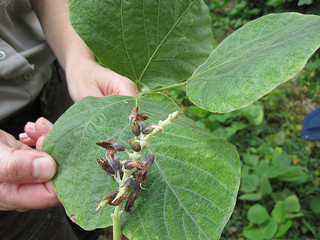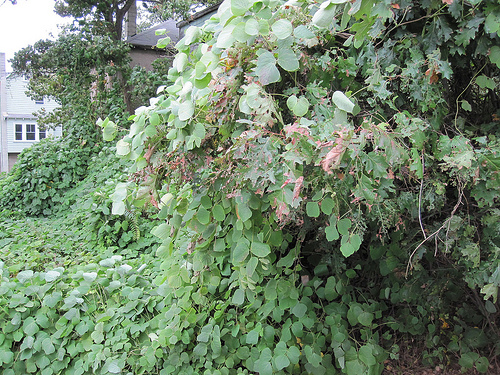Kudzu
(Pueraria montana ssp. lobata)
Family: Legume family (Fabaceae)
Native Range: Asia
 Kudzu, known as “the plant that ate the south” is a perennial, semi-woody vine that can reach 100 feet in length. The alternate, compound leaves consist of three broad leaflets, which are hairy on the undersides and 4-6 inches in length. The clusters of purple flowers, which have a grape-like fragrance, bloom in mid-summer. The fruits are flat, hairy, brown pods up to 8 inches in length. Kudzu, which is native to Japan, was brought to the United States for erosion control. It infests forest edges, roadsides, right-of-way corridors, and old fields. Kudzu has a massive tap root system that can penetrate 9 feet into the soil.
Kudzu, known as “the plant that ate the south” is a perennial, semi-woody vine that can reach 100 feet in length. The alternate, compound leaves consist of three broad leaflets, which are hairy on the undersides and 4-6 inches in length. The clusters of purple flowers, which have a grape-like fragrance, bloom in mid-summer. The fruits are flat, hairy, brown pods up to 8 inches in length. Kudzu, which is native to Japan, was brought to the United States for erosion control. It infests forest edges, roadsides, right-of-way corridors, and old fields. Kudzu has a massive tap root system that can penetrate 9 feet into the soil.
Reproductive/Dispersal Methods
Seeds are dispersed by animals, wind, and water currents. The seeds often are not fertile, and vegetative spread by runners and rhizomes is more common.
Similar Species
Several native vines exist that bare some similarity to Kudzu.
- Groundnut (Apios americana) a native vine in the legume family, also has compound leaves and purple flowers. However, it is much smaller, herbaceous, and has 5-7 leaflets.
- Poison ivy (Toxicodendron radicans), like kudzu, climbs high into trees and has compound leaves with 3 leaflets, but the leaflets are shiny, narrower, and lack the hairiness of kudzu leaves.
- Grape (Vitis spp.) is another high-climbing vine.
- Oriental bittersweet (Celastrus orbiculatus) have simple rather than compound leaves.
Impacts
 Kudzu is notorious for its destructive impacts in forests of the southeastern states. It climbs over and smothers trees, and can form massive ground mats, destroying all other vegetation.
Kudzu is notorious for its destructive impacts in forests of the southeastern states. It climbs over and smothers trees, and can form massive ground mats, destroying all other vegetation.
Distribution
Kudzu is distributed throughout the eastern United States from Massachusetts to Florida and west to Nebraska and Texas. It also occurs in Washington and Oregon. In New England, there are several occurrences in Connecticut near the coast and also in eastern Massachusetts near the coast.
Sources and Links:
Invasive Plant Atlas of New England (IPANE)
https://www.invasive.org/browse/subinfo.cfm?sub=2425
Invasive.org: Center for Invasive Species and Ecosystem Health
http://www.invasive.org/browse/subinfo.cfm?sub=37840